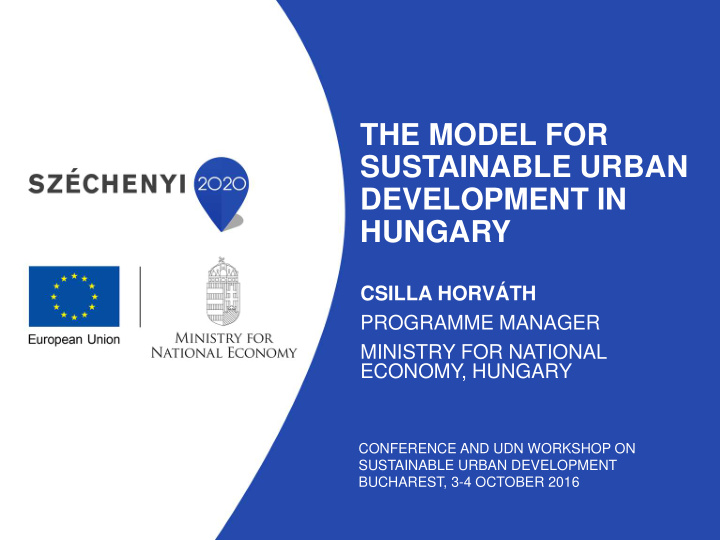



THE MODEL FOR SUSTAINABLE URBAN DEVELOPMENT IN HUNGARY CSILLA HORVÁTH PROGRAMME MANAGER MINISTRY FOR NATIONAL ECONOMY, HUNGARY CONFERENCE AND UDN WORKSHOP ON SUSTAINABLE URBAN DEVELOPMENT BUCHAREST, 3-4 OCTOBER 2016
TOP Priorities 1. Development of regional economic 3,71% environment for promoting employment 24,24% 2. Enterprise friendly and population preserving settlement development 31,43% 3. Transition into a low carbon economy, especially in urban areas 4. Development of local community services and strengthening of social co-operation 12,00% 5. Human resource developments, social inclusion and employment promotion at county and local level 6. Sustainable urban development in cities with 7,28% county rights 16,32% 5,02% 7. Community-led Local Development in cities (urban CLLD)
SUSTAINABLE URBAN DEVELOPMENT (ART. 7) DESCRIPTION OF THE PRIORITY AXIS TOP 6: • based on GDP • based on the population of the town • 7% of ERDF in Hungary • additional ESF funding • integrated programme, integrated projects
SUSTAINABLE URBAN DEVELOPMENT (ART. 7) DETAILS: • dedicated priority axis (TOP 6) • for the 22 largest cities in the less developed regions • Town Municipalities are responsible for planning, and involved in the decision-making process • planning, implementing and monitoring the program documents • selection procedure in specific calls for proposal
SUSTAINABLE URBAN DEVELOPMENT (ART. 7) TERRITORIAL PLANNING AND SELECTION SYSTEM Tender Call Reciving grant applications Evaluation MANAGING Decision Making AUTHORITY CR Town Committee Approval Project Development Implementation
SUSTAINABLE URBAN DEVELOPMENT (ART. 7) BASE DOCUMENTS IN TOWNS: • Integrated settlement development strategies – covering the whole area of the town and funding in general • Integrated territorial programmes – implementation oriented plan funded by the EU Integrated settlement development strategy Integrated territorial programme
SUSTAINABLE URBAN DEVELOPMENT (ART. 7) ISDS • 2007-08: methodology for integrated urban development strategy – all towns have ISDS • 2013: reviewing the strategy contributing to the MA • ITP was made on the basis of the updated strategy in consistency with the TOP DEVELOPMENTS OF THE ITP • first phase of the calls for proposal is closed • the project proposals are under evaluation or in contracting phase
SUSTAINABLE URBAN DEVELOPMENT (ART. 7) LOCAL AUTHORITIES • 2007-13: integrated urban development in the seven ROPs: urban development companies • separate units by the municipalities for urban development (either departments or companies) • at the municipality separate department for project proposals design and evaluation • statement according to which the project proposal is in line with the ITP and the strategy, and contribute to the results of the TOP
SUSTAINABLE URBAN DEVELOPMENT (ART. 7) SUPPORTING CATEGORIES COVERED BY TOP 6 PRIORITY AXIS 6.1. Local economy development by local governments, aimed at the recovery of economy and increasing employment • Development of infrastructure and service-related businesses • Socially and environmentally sustainable tourism development • Transport development for economic development and for stimulating labour mobility 6.2. Development of family friendly institutes and public services helping people to find employment (child welfare basic care (creche, family day-care centres etc.) and kindergarten care ) 6.3 Economy stimulating and population preserving urban development (urban development, drainage of rainwater in settlement areas) 6.4. Sustainable urban transport development
SUSTAINABLE URBAN DEVELOPMENT (ART. 7) SUPPORTING CATEGORIES COVERED BY TOP 6 PRIORITY AXIS 6.5. Increasing the energy efficiency of local governments and the ratio of renewable energy consumption 6.6. Development of urban public services (primary health care, primary social services) 6.7. Regeneration of deprived urban areas 6.8. Employment development related to economic development (local employment partnerships (pacts)) 6.9. Local programmes aimed at social cohesion (advancement of social cooperation, strengthening local identity and cohesion)
THANK YOU FOR YOUR ATTENTION.
Recommend
More recommend